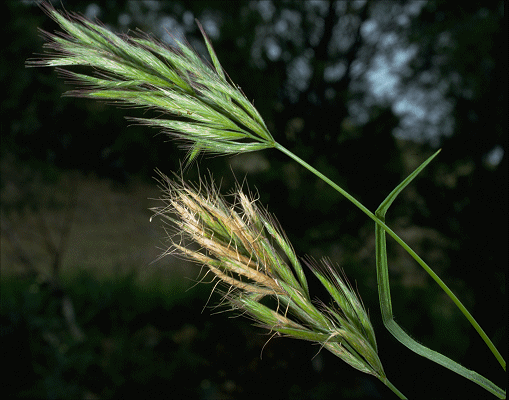 |
 |
|
 |
 |
|

Bromus alopecuros Poir. |
Derivation
Bromus L., Sp. Pl. 76 (1753); from the Greek bromos (oat),
out of broma (food).
alopecuros- resembling Alopecuros.
Published in
Voy. Barb. 2: 100 (1789).
Common synonyms
Bromus alopecuroides Poiret
Bromus lanceolatus Roth
Habit
Annual, tufted. Basal leaf sheaths pilose. Culms erect or geniculately ascending,
10–80 cm tall. Leaf-sheaths pubescent. Ligule an eciliate membrane. Leaf-blades
5–22 cm long, 1–5 mm wide. Leaf-blade surface pilose or hirsute.
Inflorescence
Inflorescence compound, a panicle. Panicle open or contracted, linear or elliptic
or oblong, 2–20 cm long, 1–3 cm wide. Primary panicle branches appressed
or spreading. Panicle branches stiff.
Spikelets
Spikelets ascending, solitary. Pedicels 0.8–7 mm long. Fertile spikelets
many flowered, comprising 6–11 fertile florets, with diminished florets
at the apex, lanceolate or oblong or ovate, laterally compressed, 20–45
mm long, 3–7 mm wide, breaking up at maturity. Spikelets disarticulating
below each fertile floret.
Glumes
Glumes persistent. Lower glume lanceolate, 5–10 mm long, 75–90%
length of upper glume, membranous, 3–5-nerved. Lower glume apex acute.
Upper glume lanceolate, 8–20 mm long, 66% of length of adjacent fertile
lemma, membranous, 5–9-nerved, midnerve scaberulous. Upper glume apex acute.
Florets
Fertile lemma trullate, laterally compressed, 9–18 mm long, 3–5 mm
wide, chartaceous, 7–9-nerved. Lemma surface glabrous or hirsute. Lemma
apex dentate, 2-fid, 1-awned. Median (principal) awn dorsal, arising 66–75%
way up back of lemma, straight or curved or geniculate, spreading and briefly
coiled at base of limb, flat below, 6–20 mm long overall. Palea surface
glabrous. Apical sterile florets resembling fertile though underdeveloped. Lodicules
2, membranous. Anthers 3, 0.5–1.5 mm long. Ovary with a fleshy appendage
above style insertion, pubescent on apex. Grain with adherent pericarp, hairy
at apex, apex fleshy. Hilum linear.
Continental Distribution:
Europe, Africa, Temperate Asia, Australasia, North America.
Australian Distribution:
Western Australia, Queensland, South Australia, Victoria, Tasmania.
Western Australia: Drummond, Dale, Avon. Queensland: Maranoa. New South Wales: Central Coast, Northern Tablelands, Southern Tablelands, North-Western Slopes, Central-Western Slopes, South-Western Slopes, South-Western Plains. South Australia: Northern Lofty, Murray, Southern Lofty, Kangaroo Island, South-eastern. Victoria: Murray Mallee, Wimmera, Wannon, Grampians, Riverina, Midlands, Victorian Volcanic Plain, Eastern Highlands, Gippsland Plains, East Gippsland. Tasmania: East Coast.
Classification. (GPWG
2001):
Pooideae: Bromeae
Notes
Introduced. Native of the Mediterranean. An occasional weed of crops, pastures
and roadsides. Flowers Oct.–Dec. Fruits Oct.–Jan.
The records of Bromus lanceolatus in Victoria and South Australia are
recognised here as Bromus alopecuros.

Inflorescence (photo)
© J.Hosking